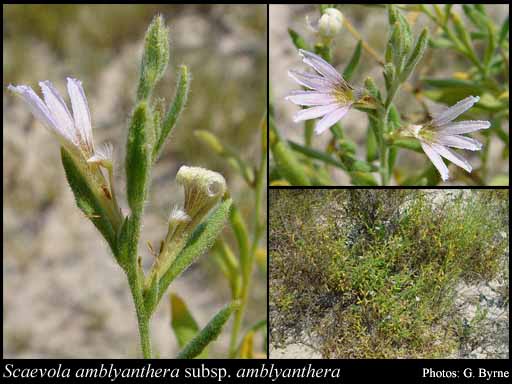- Conservation Code
- Not threatened
- Naturalised Status
- Native to Western Australia
- Name Status
- Current
Spreading shrub, to 0.3 m high. Fl. blue, May to Jul. Stony soils.

Scientific Description
Stems unribbed. Leaves flat, 10-25 mm long, 2-7 mm wide, Indumentum present, with dense, glandular hairs; margins entire or toothed. Bracteoles present, 4.5-5.5 mm long, hairy, with simple hairs. Pedicel absent (flowers sessile). Calyx lobes present, Calyx length 5-6.2 mm long, hairy, with sparse, simple hairs. Corolla mauve, 11-13 mm long, without auricles, not spurred, hairy on the outside, with sparse, simple hairs, hairy on the inside; central lobes 3.5-5 mm long, with wings; outer lobes 3.5-4 mm long, wings present on both sides, 0.3-0.5 mm wide. Anthers free. Ovary inferior, not gibbose; style 5-7.5 mm long, glabrous; indusium single, hairy; ovules one or two. Flowers in May, June and July. Occurs in the Pilbara (PIL), Little Sandy Desert(LSD), Dampier land (DL) and Ord-Victoria Plains (OVP) IBRA Region(s), of the Northern (N) and Eremaean (E) Botanical Province.
Distribution
- IBRA Regions
- Carnarvon, Dampierland, Great Sandy Desert, Little Sandy Desert, Ord Victoria Plain, Pilbara, Tanami.
- IBRA Subregions
- Cape Range, Chichester, Fitzroy Trough, Hamersley, Mackay, McLarty, Pindanland, Purnululu, Rudall, South Kimberley Interzone, Tanami Desert.
- Local Government Areas (LGAs)
- Ashburton, Broome, Derby-West Kimberley, East Pilbara, Halls Creek.